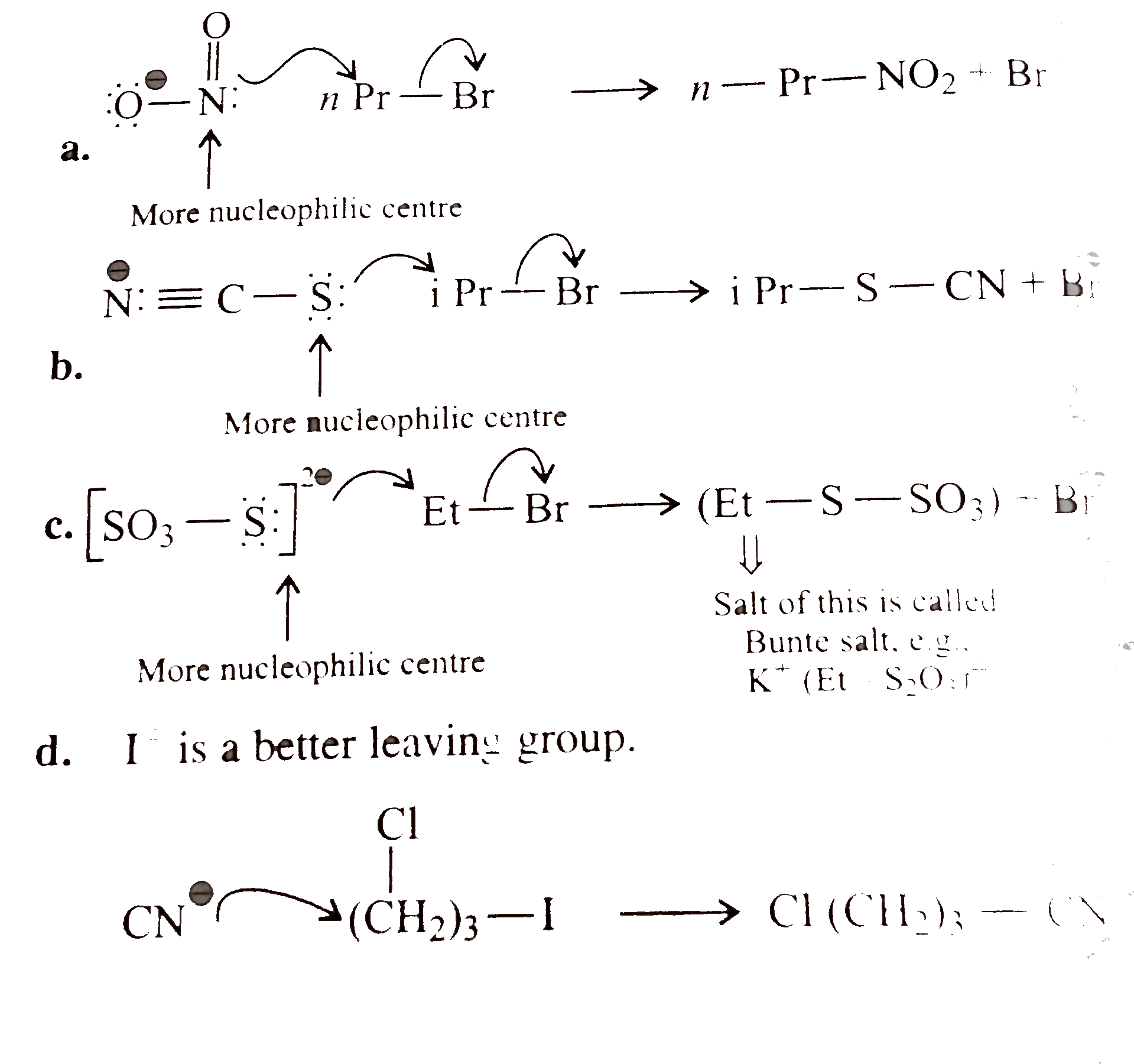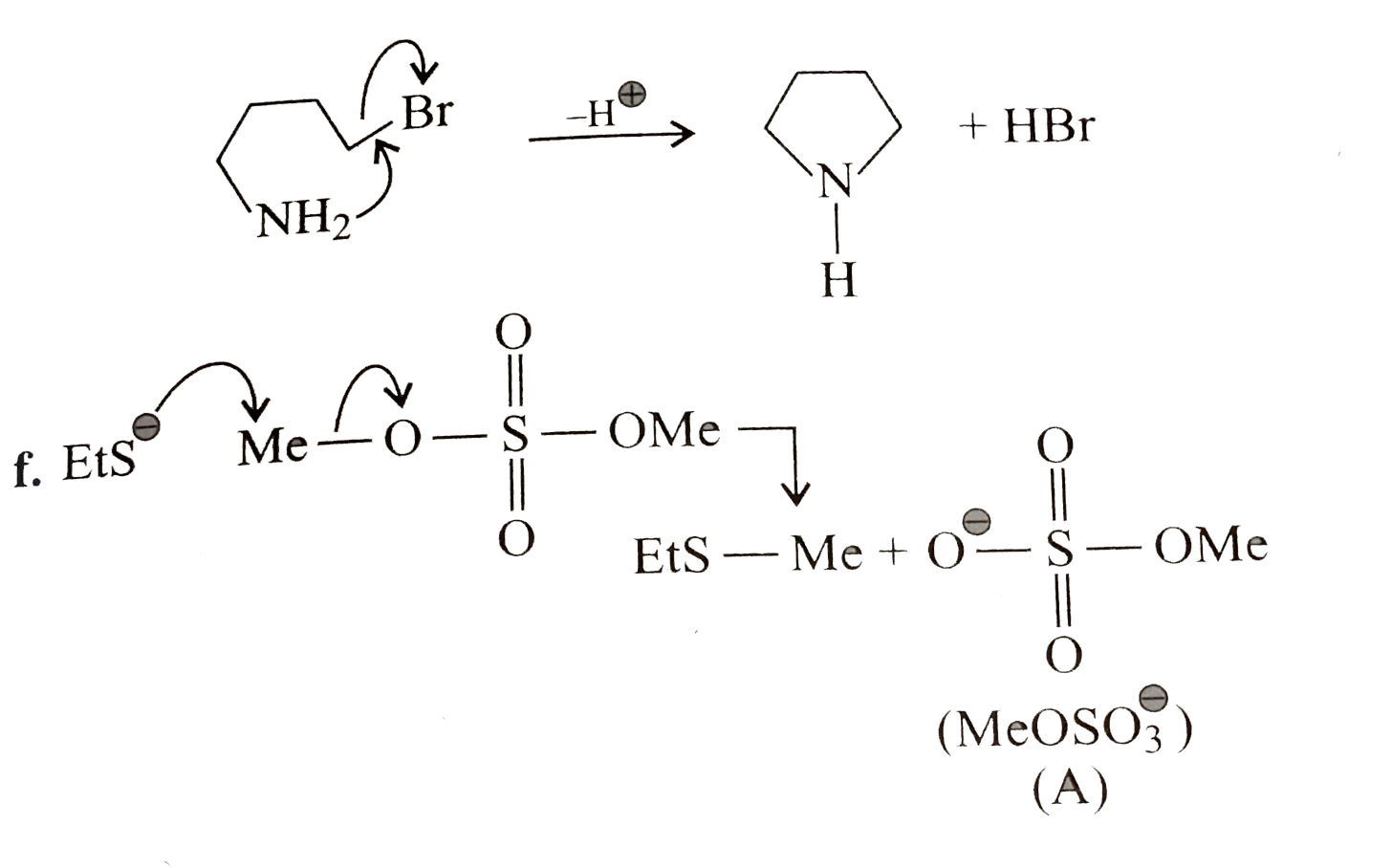Give the organic products of the following reactions :
nPrBr+:O:∣∣N..−..O..:Θ
Video Solution
Text Solution
The nucleophiles in (a),(b) and (c) are ambident, therefore, the nucleophilic centre reacts more, even though the other atom bears a negative charge.
(a) 
( e) When the nucleophile and the leaving group are part of the same molecule, an intramolecular displacement occurs it a three-, five-, or six-memebered ring is formed.

(A) is a good leaving group because of the very weak conjugate base of a strong acid (MeOSO2OH)- the kin of H2SO4
(g) 
(B) is a good leaving group because of the very weak conjugate base of a very strong acid (HNO3).
(h) No reaction.
H2S is a stronger acid than HCN
NSӨ is a weaker conjugate base (CB) of H2S
HSӨ is a weaker (CB) than CNӨ .
A weaker base cannot displace a stronger base.

C is the weakest conjugate base of the strongest acid (FSO2.OH) (fluoro sulphurous acid).
IӨ is a stronger nucleophile but a weak base, and is stronger than (FSOӨ3) .
|
Updated on:21/07/2023
Topper's Solved these Questions
- BOOK - CENGAGE CHEMISTRY ENGLISHCHAPTER - ORGANIC REACTION MECHANISMEXERCISE - Solved Example33videos
ORGANIC REACTION MECHANISM
- BOOK - CENGAGE CHEMISTRY ENGLISHCHAPTER - ORGANIC REACTION MECHANISMEXERCISE - Subjective19videos
ORGANIC REACTION MECHANISM
- BOOK - CENGAGE CHEMISTRY ENGLISHCHAPTER - NCERT BASED EXERCISEEXERCISE - Chemical Equilibrium73videos
NCERT BASED EXERCISE
- BOOK - CENGAGE CHEMISTRY ENGLISHCHAPTER - P-BLOCK GROUP 13 - BORON FAMILYEXERCISE - Exercise Archives (Subjecive)9videos
P-BLOCK GROUP 13 - BORON FAMILY
Similar Questions
Knowledge Check
- Question 1 - Select One
The major product formed in the following reaction is
CH3−CH3∣C∣H−CH2BrCH3O−−−−−→CH3OHACH3−CH3∣C∣H−CH2OCH3BCH3−CH∣OCH3−CH2CH3CCH3−CH3∣C=CH2DCH3−CH3∣C∣OCH3−CH3 - Question 2 - Select One
What is the major product of the following reaction ?
CH3−C≡NCH3MgI−−−−→Et2OH3O⊕−−−→ACH3−CH2−NH−CH3B CCH3−O∣∣C−CH3DCH3−CH2−O∣∣C−OH
CCH3−O∣∣C−CH3DCH3−CH2−O∣∣C−OH - Question 3 - Select One
Arrange the following anions in decreasing order of stability :
H−O∣∣C−өCH−O∣∣C−H(P) CH3−O∣∣C−өCH−O∣∣C−H(Q)
CH3−O∣∣C−өCH−O∣∣C−..O..−CH3(R)AR>Q>PBQ>R>PCP>R>QDP>Q>R
In the following SN1 reaction:
_S01_431_Q01.png) OH⊕−−→SN1(A) is View Solution
OH⊕−−→SN1(A) is View SolutionMajor product of the given reaction is
CH3−CH3∣C∣CH3−CH∣CI−CH3C2H5O−−−−−−→View SolutionCalculate the formal charge on each in the following electron-dot structure of SO2.
:⋅⋅O⋅⋅−⋅⋅S=⋅⋅O⋅⋅View SolutionOrder of rate of reaction of following compound with phenyl magnesium bromide is :
Me−O∣∣CI−Cl,Me−O∣∣CII−H,Me−O∣∣CIII−O−EtView SolutionExamine the following resonating structures of formic acid and arrange them in decreasing order of stability :
H−O∣∣C−..O..H(I)↔H−өO∣C=⊕O−H(II)↔H−өO∣C⊕−OH(III)↔H−O⊕∣Cө−OH(IV)View Solution

_2019_CBT3_E01_007_Q01.png)